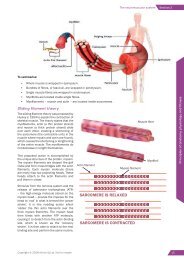Active IQ Level 3 Diploma in Health and Fitness (sample manual)
For more information, please visit http://www.activeiq.co.uk/qualifications/level-3/active-iq-level-3-diploma-in-health-and-fitness
For more information, please visit http://www.activeiq.co.uk/qualifications/level-3/active-iq-level-3-diploma-in-health-and-fitness
You also want an ePaper? Increase the reach of your titles
YUMPU automatically turns print PDFs into web optimized ePapers that Google loves.
Manual<br />
<strong>Active</strong> <strong>IQ</strong> <strong>Level</strong> 3 <strong>Diploma</strong> <strong>in</strong><br />
<strong>Health</strong> <strong>and</strong> <strong>Fitness</strong> Group W –<br />
Unit 65 Underst<strong>and</strong><strong>in</strong>g how to<br />
Lead a Team <strong>in</strong> <strong>Active</strong> Leisure<br />
Version A<strong>IQ</strong>005716
The role of a team leader<br />
Leadership is the skill of lead<strong>in</strong>g a team, <strong>and</strong> develop<strong>in</strong>g that team to be effective <strong>and</strong> efficient. The<br />
personal attributes of the leader are therefore, fundamental.<br />
It is often said of the sport <strong>and</strong> active leisure <strong>in</strong>dustry that there are too many managers <strong>and</strong> too few<br />
leaders. The formidable <strong>and</strong> successful manager is the one who is an equally good leader.<br />
Effective leadership<br />
John Adair, who is one of the foremost management th<strong>in</strong>kers, identifies the fact that there are three crucial<br />
elements to effective team leadership <strong>in</strong> what he refers to as 'action centred leadership':<br />
• achieve the task<br />
• develop <strong>in</strong>dividual team members<br />
• build the team<br />
The po<strong>in</strong>t which Adair makes is that all three are equally important <strong>and</strong> an over emphasis on any one<br />
leads to <strong>in</strong>efficient leadership.<br />
Th<strong>in</strong>k<strong>in</strong>g about John Adair’s 'action centred leadership' model, make notes on the possible<br />
consequences of merely address<strong>in</strong>g two of the three functions.<br />
For example, suppos<strong>in</strong>g the emphasis was on gett<strong>in</strong>g the task completed <strong>and</strong> build<strong>in</strong>g<br />
the team?<br />
Discuss with your tutor/assessor whether you th<strong>in</strong>k Adair has got it about right.<br />
If not, why not?<br />
Activity<br />
Leadership theory <strong>and</strong> style<br />
The study of leadership style <strong>and</strong> the theories associated with it is a fasc<strong>in</strong>at<strong>in</strong>g area. We are go<strong>in</strong>g to<br />
consider some of the key authors <strong>and</strong> theories <strong>in</strong> consider<strong>in</strong>g what may be the best leadership style.<br />
We have already mentioned the work of John Adair <strong>and</strong> his model of action- centred leadership, which<br />
supports achiev<strong>in</strong>g the task by develop<strong>in</strong>g the <strong>in</strong>dividual, whilst build<strong>in</strong>g the team. Over the years however,<br />
not all leadership theorists have been quite so people-friendly<br />
The Scientific Management School<br />
Management <strong>and</strong> leadership theory can be traced back to the early years of the twentieth century. One of<br />
the first of the theorists was an American called Frederick W<strong>in</strong>slow Taylor. He developed what became<br />
known as the Scientific Management School. Taylor believed that if a researcher was able to identify the<br />
best method of carry<strong>in</strong>g out work, then the worker should be told to do it <strong>in</strong> that particular way, <strong>and</strong> <strong>in</strong><br />
do<strong>in</strong>g so, the job would be done <strong>in</strong> the most efficient way, tak<strong>in</strong>g the m<strong>in</strong>imum of time. Put simply, workers<br />
were told what to do <strong>and</strong> how to do it <strong>and</strong> their responsibility was merely for carry<strong>in</strong>g out the task. Initiative<br />
was not rewarded, nor welcomed. Workers merely followed <strong>in</strong>structions <strong>in</strong> an almost mach<strong>in</strong>e-like fashion,<br />
to achieve the most efficient outcome.<br />
Copyright © 2019 <strong>Active</strong> <strong>IQ</strong> Ltd. Not for resale | 3
Bureaucratic leadership style<br />
Bureaucratic leadership is where the manager manages “by the book.¨ Everyth<strong>in</strong>g must be done accord<strong>in</strong>g<br />
to procedure or policy. If it isn’t covered by the book, the manager refers to the next level above him or her.<br />
This style can be effective when:<br />
• the employees are perform<strong>in</strong>g rout<strong>in</strong>e tasks over <strong>and</strong> over aga<strong>in</strong><br />
• employees are work<strong>in</strong>g with dangerous chemicals or delicate equipment that requires a def<strong>in</strong>ite set<br />
of procedures to operate<br />
• safety or security tra<strong>in</strong><strong>in</strong>g is be<strong>in</strong>g conducted<br />
• employees are perform<strong>in</strong>g tasks that require h<strong>and</strong>l<strong>in</strong>g cash<br />
Democratic leadership style<br />
The democratic leadership style is also called the ‘participative’ style as it encourages employees to be a<br />
part of the decision mak<strong>in</strong>g process.<br />
The democratic leader keeps their team members <strong>in</strong>formed about everyth<strong>in</strong>g that affects their work <strong>and</strong><br />
shares both decision-mak<strong>in</strong>g <strong>and</strong> problem-solv<strong>in</strong>g responsibilities.<br />
This style requires the leader to be a coach who has the f<strong>in</strong>al say, but gathers <strong>in</strong>formation from staff<br />
members before mak<strong>in</strong>g a decision.<br />
Democratic leadership can produce a high quality <strong>and</strong> quantity of work for long periods of time. Many<br />
employees like the trust they receive <strong>and</strong> respond with cooperation, team spirit <strong>and</strong> high morale.<br />
Typically, the democratic leader:<br />
• develops plans to help team members evaluate their own performance<br />
• encourages team members to grow<br />
• recognises <strong>and</strong> encourages achievement<br />
Laissez-faire leadership style<br />
The laissez-faire leadership style is also known as the “h<strong>and</strong>s-off” style. It is one <strong>in</strong> which the leader<br />
provides little, or no direction, <strong>and</strong> gives employees as much freedom as possible. All authority or power<br />
is given to the employees <strong>and</strong> they must determ<strong>in</strong>e goals, make decisions <strong>and</strong> resolve problems on their<br />
own.<br />
This is an effective style to use when:<br />
• employees are highly skilled, experienced <strong>and</strong> educated<br />
• employees have pride <strong>in</strong> their work <strong>and</strong> the drive to do it successfully on their own<br />
• outside experts, such as staff specialists or consultants are be<strong>in</strong>g used<br />
• employees are trustworthy <strong>and</strong> experienced<br />
In no more than 20 words write down your own leadership style. Consider the effectiveness of this<br />
style.<br />
In no more than 20 words write down your l<strong>in</strong>e manager’s leadership style. Consider the<br />
effectiveness of this style.<br />
List the disadvantages of the laissez-faire style of leadership when operated <strong>in</strong> the wrong<br />
environment.<br />
Activity<br />
Copyright © 2019 <strong>Active</strong> <strong>IQ</strong> Ltd. Not for resale | 5
The team will also develop its own team culture <strong>and</strong> group norms. Such norms were referred to above <strong>in</strong><br />
relation to the work of Tuckman <strong>and</strong> are particularly important to effective teamwork. If, for example, the<br />
philosophy of the group is to work hard <strong>and</strong> conscientiously, then anybody who doesn’t come <strong>in</strong> l<strong>in</strong>e with<br />
this work ethic will very soon f<strong>in</strong>d themselves isolated <strong>and</strong> outside of the protection offered by the group.<br />
List any team build<strong>in</strong>g exercises used when you jo<strong>in</strong>ed your current team.<br />
Consider the effectiveness of each exercise.<br />
Every member of the team needs to feel that they have a part to play with<strong>in</strong> the team <strong>and</strong> are a valued<br />
member of the team. They also need to feel that they are able to use their own <strong>in</strong>itiative <strong>and</strong> offer their<br />
Activity<br />
op<strong>in</strong>ions.<br />
Very often the first stage of problem-solv<strong>in</strong>g is ‘bra<strong>in</strong>storm<strong>in</strong>g’ where all members of the team are encouraged<br />
to offer op<strong>in</strong>ions or make suggestions toward solv<strong>in</strong>g the problem. A strategy is then developed from this<br />
bra<strong>in</strong>storm<strong>in</strong>g exercise. Consequently, if team leaders are serious about develop<strong>in</strong>g their team they must<br />
give all team members the confidence to make suggestions <strong>and</strong> be heard with<strong>in</strong> the team environment.<br />
This will be encouraged by always acknowledg<strong>in</strong>g the contributions made by <strong>in</strong>dividuals <strong>and</strong> never tak<strong>in</strong>g<br />
the credit for other peoples’ ideas<br />
Consider whether you are encouraged to offer your op<strong>in</strong>ion with<strong>in</strong> the team that you work with.<br />
List any examples of this.<br />
How to motivate <strong>and</strong> support your team<br />
Activity<br />
Motivation theory<br />
Over the years there have been a number of motivation theories that have sought to expla<strong>in</strong> how best to<br />
underst<strong>and</strong> how people work <strong>and</strong> how to get the best from them.<br />
The hierarchy of needs<br />
Perhaps the most famous of all of the motivation theorists is Abraham Maslow. Maslow put forward the<br />
concept of people progress<strong>in</strong>g through various stages of a pyramid, which he referred to as the ‘Hierarchy<br />
of Needs Theory’.<br />
The theory states that <strong>in</strong> order for somebody to be truly motivated <strong>in</strong> the workplace, there are a series of<br />
progressive needs that must be satisfied.<br />
Physiological needs such as sleep <strong>and</strong> sustenance must be met first <strong>and</strong> it is only when they are that the<br />
next level of needs will be considered.<br />
The next level of Maslow’s hierarchy is the need for security <strong>and</strong> safety <strong>and</strong> would <strong>in</strong>clude a place to live,<br />
a secure environment <strong>and</strong> freedom from hostility. This level is followed by so called ‘love needs’, for<br />
example, the need to be accepted by colleagues, friends <strong>and</strong> loved ones. This will then <strong>in</strong> turn be followed<br />
by ‘esteem needs’ which are centred on the need for self-belief, self-confidence <strong>and</strong> self-esteem.<br />
10 | Copyright © 2019 <strong>Active</strong> <strong>IQ</strong> Ltd. Not for resale
If all these needs are met, either with<strong>in</strong> a work<strong>in</strong>g environment or elsewhere, the <strong>in</strong>dividual will be motivated<br />
to achieve the top level of the pyramid, which is referred to as ‘self-actualisation’. This is the po<strong>in</strong>t at which<br />
the person arrives at their set goal <strong>and</strong> where they beg<strong>in</strong> to feel fulfilled, successful <strong>and</strong> truly motivated. If<br />
Maslow’s ‘hierarchy of needs’ are met for employees with<strong>in</strong> an organisation those <strong>in</strong>dividuals will become<br />
highly motivated <strong>and</strong> effective members of that organisation.<br />
The Motivation Hygiene Theory<br />
Another important th<strong>in</strong>ker <strong>in</strong> motivation theory is the American, Frederick Herzberg. Herzberg carried out<br />
a series of experiments to f<strong>in</strong>d out what led to satisfaction <strong>and</strong> dissatisfaction at work. The factors that<br />
related to satisfaction he called ‘motivators’, <strong>and</strong> those that led to dissatisfaction he called ‘de-motivators’<br />
or ‘hygiene factors’ - hence the title of his work, the ‘Motivation Hygiene Theory’.<br />
The th<strong>in</strong>k<strong>in</strong>g beh<strong>in</strong>d the theory is that although good hygiene does not particularly make you well, it can<br />
prevent you from becom<strong>in</strong>g unwell. In the same way, even if ‘de-motivators’ or ‘hygiene factors’ are<br />
addressed <strong>in</strong> the workplace, this does not necessarily br<strong>in</strong>g about job satisfaction. If ignored, however, their<br />
presence will <strong>in</strong>crease the chances of dissatisfaction <strong>in</strong> the workplace.<br />
Herzberg’s ‘motivators’ were:<br />
• achievement<br />
• recognition<br />
• the job itself<br />
• responsibility<br />
• advancement <strong>and</strong> growth<br />
If these are present, they tend to make people feel good about their job. The ‘hygiene factors’ or the ‘demotivators’<br />
<strong>in</strong>cluded:<br />
• company policy<br />
• adm<strong>in</strong>istrative arrangements<br />
• supervision<br />
• relationships with supervisors, peers <strong>and</strong> subord<strong>in</strong>ates<br />
• work<strong>in</strong>g conditions<br />
• salary<br />
• issues <strong>in</strong> the person’s personal life<br />
• status<br />
• security<br />
So how does this translate <strong>in</strong>to motivat<strong>in</strong>g staff? Put simply, if an <strong>in</strong>dividual is employed with<strong>in</strong> what they<br />
consider to be a ‘dead end’ job with limited prospects, or they are employed on a part-time casual contract<br />
with no security of tenure they are unlikely to be truly motivated. These are the very people that under<br />
McGregor’s ‘XY theory’ will become theory X type employees.<br />
List the th<strong>in</strong>gs that make you feel good about your job.<br />
List the th<strong>in</strong>gs that make you feel fed up about your job.<br />
Consider how each relates to Herzberg’s theory.<br />
Motivation methods<br />
What are the best methods to motivate <strong>and</strong> support the people with<strong>in</strong> your team?<br />
Activity<br />
Copyright © 2019 <strong>Active</strong> <strong>IQ</strong> Ltd. Not for resale | 11
<strong>Active</strong> <strong>IQ</strong><br />
Dryden House<br />
St. Johns Street<br />
Hunt<strong>in</strong>gdon<br />
PE29 3NU<br />
T 01480 467 950<br />
F 01480 456 283<br />
<strong>in</strong>fo@activeiq.co.uk<br />
www.activeiq.co.uk<br />
<strong>Active</strong> <strong>IQ</strong> wishes to emphasise that<br />
whilst every effort is made to ensure<br />
accuracy, the material conta<strong>in</strong>ed with<strong>in</strong><br />
this document is subject to alteration<br />
or amendment <strong>in</strong> terms of overall<br />
policy, f<strong>in</strong>ancial or other constra<strong>in</strong>ts.<br />
Reproduction of this publication is<br />
prohibited unless authorised by <strong>Active</strong> <strong>IQ</strong><br />
Ltd. No part of this document should be<br />
published elsewhere or reproduced <strong>in</strong> any<br />
form without prior written permission.<br />
Copyright © 2019 <strong>Active</strong> <strong>IQ</strong> Ltd. Not for resale.

















